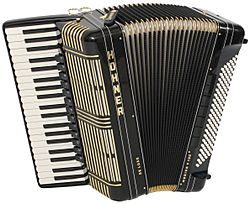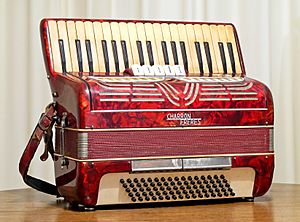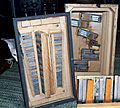Accordion facts for kids

An accordion
|
|
| Classification | Keyboard |
|---|---|
| Inventor(s) | Friedrich Buschmann |
| Developed | 1822 |
| Related instruments | |
| Concertina | |
Accordions are amazing musical instruments that look like a box. They are part of the free reed aerophone family, which means they make sound using air flowing over vibrating reeds. You might hear them called a "squeezebox" because of how they are played! Someone who plays the accordion is called an accordionist.
You play an accordion by pushing and pulling its bellows (the pleated part). At the same time, you press buttons or keys. This makes small flaps, called pallets, open up. Air then flows over thin strips of metal, called reeds. These reeds vibrate and create the sound you hear.
Usually, players use their right hand for the melody (the main tune) on keys or buttons. Their left hand plays the accompaniment. This includes bass notes and pre-set chords, which are groups of notes played together.
Accordions are popular all over the world. In some places, they are used in pop music. In other regions, like Europe, North America, and South America, they are often heard in dance-pop and folk music.
You can also find accordions in many different music styles. These include Cajun music, zydeco, and jazz music. They are even used in classical music, both for solo performances and with orchestras. The piano accordion is so special that it's the official city instrument of San Francisco, California!
How the Accordion Was Invented
The basic idea for the accordion is thought to have come from Berlin. A person named Christian Friedrich Ludwig Buschmann is often given credit for inventing it in 1822.
However, some researchers believe earlier versions might have existed. For example, some simple accordions were made in Tula, Russia, starting around 1820.
Spreading Across the World
By the late 1840s, accordions were already very popular. Factories in Tula were making thousands of instruments each year. By 1866, over 50,000 accordions were being produced yearly in Tula and nearby villages. Just eight years later, by 1874, the yearly production rate jumped to over 700,000! This shows how quickly the accordion became a favorite instrument.
Images for kids
-
An accordion player performing on a street in Quito, Ecuador.
-
Brazilian accordionist Dominguinhos.
See also
 In Spanish: Acordeón para niños
In Spanish: Acordeón para niños

















